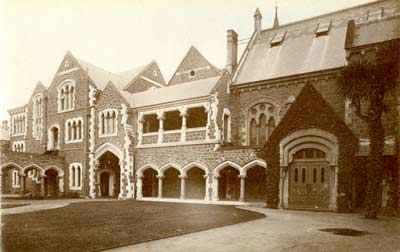It would have been an interesting year for local contractors, as the 1888 earthquake damaged buildings in Christchurch and caused the Cathedral spire to topple. Designed by Benjamin Mountfort at a cost of just £1,477, the Classics Building looks out onto what is now Rolleston Avenue and proclaims its purpose to the world with the Latin inscription over the entrance which reads ‘Salvete intrantes’ or ‘Greetings to those who enter’.The Greek inscription (from Pindar’s 12th Pythian Ode) over fireplace in main Classics lecture room sets a slightly more serious tone, for it translates to ‘If there is any prosperity among men, it does not show itself without toil.’
The Classics Building remained reasonably intact until extensions were undertaken in 1917, adding the West Block to the Rolleston Avenue frontage, which connected Classics to the School of Art. Under the influence of Samuel Hurst Seager’s plan, the West Block enabled the creation of a traditional quadrangle layout in the College grounds. Designed by Collins and Harman for £5,807, the West Block features three impressive bays of arched windows which enclosed a curved staircase. The West Block became home to a large lecture hall, known as Room 15 which had a steeply tiered floor. It is rumoured that during one of James Hight’s lectures on history in the 1920s a student sent a swede bumping down the tiers. Unfazed, Hight declared “I suspect that someone in the back row has just lost his head.”

